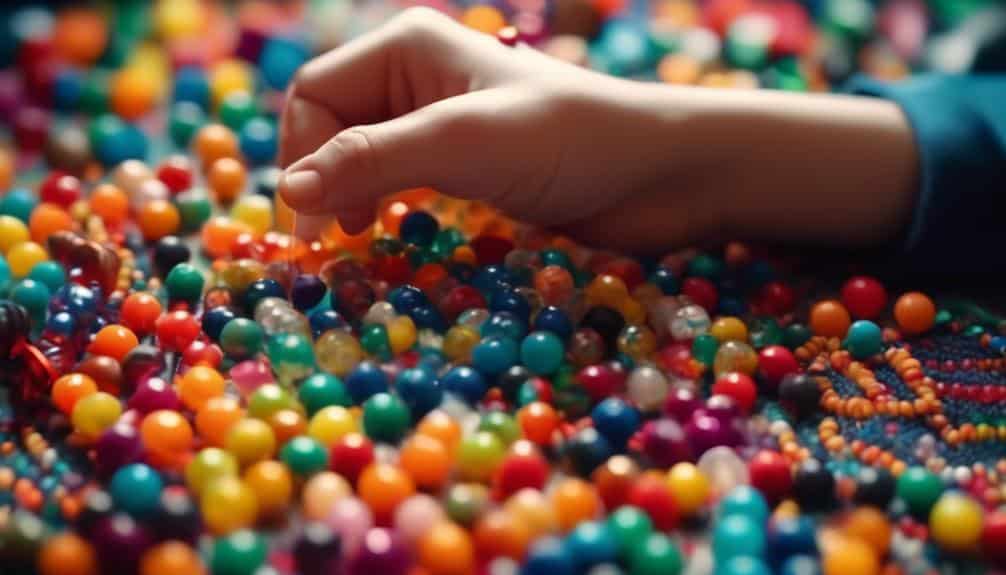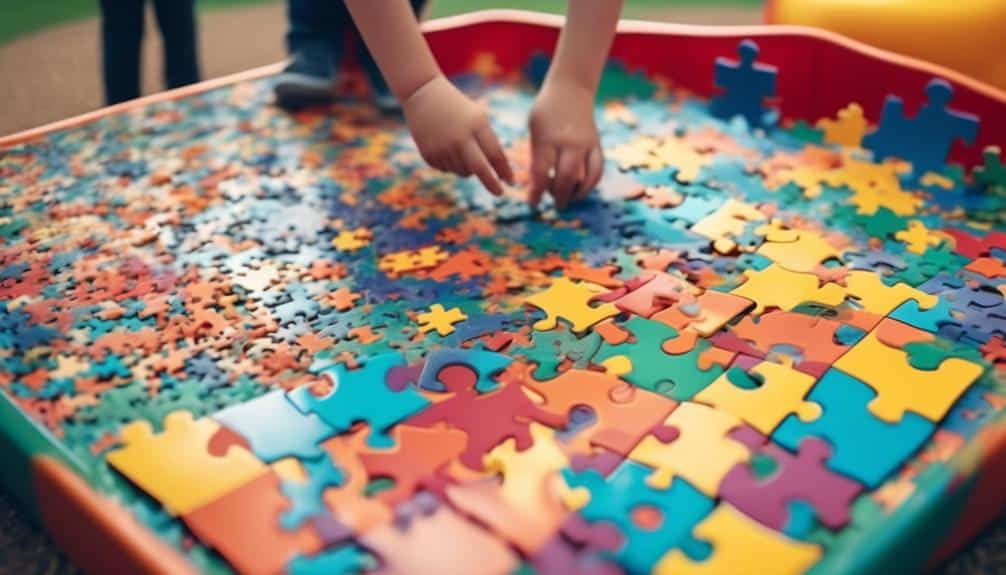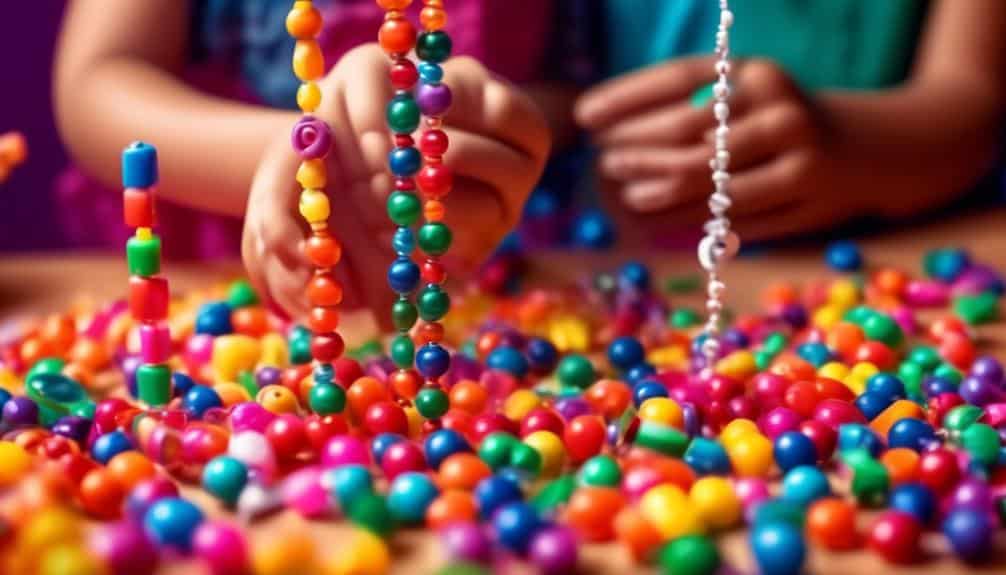Developing fine motor skills is critical to early childhood education, laying the foundation for various daily activities and academic tasks. As educators and parents attentively seek out effective methods to support this area of growth, the role of play in skill acquisition cannot be overstated. The following discussion introduces seven thoughtful and engaging games to enhance children’s fine motor abilities. These activities not only encourage the development of precise hand movements and coordination but also foster a playful and educational learning environment. From the intricate manipulation of beads to the strategic placement of stickers, each game is crafted to challenge and improve children’s agility and control.
To grasp the full potential of these activities and understand their impact on childhood development, we shall explore each game’s underlying mechanics and benefits, considering how they can be seamlessly integrated into a child’s daily routine.
Key Takeaways
- Fine motor skill games, such as sticker fun and clothespin clip art, promote creativity, decision-making, and problem-solving.
- Coin sorting games and puzzle piece hunts refine fine motor skills, enhance hand-eye coordination, and develop cognitive skills.
- String beads together and using them as a developmental tool improves fine motor skills, talent, and control necessary for writing and scissors.
- Playdough sculpting contests and cutting practice stations enhance fine motor skills, encourage individual expression, and require hand-eye coordination and dexterity.
Sticker Fun Challenge
Engaging children in a Sticker Fun Challenge can significantly enhance their fine motor skills and stimulate their creative abilities by arranging and applying various stickers to form a cohesive image or scene. This activity is delightful for children and serves a developmental purpose by focusing on the skill of small muscles in their hands and fingers. Peeling and positioning stickers require precise movements, fostering finger strength and agility, essential for writing, buttoning, and typing.
Give children stickers of different sizes, shapes, and themes to implement this acceptable motor skills activity. Please encourage them to conceptualize a story or landscape, utilizing the stickers to bring their vision to life on paper. This sticker fun challenge also allows children to decide on placement and pattern, enhancing their problem-solving abilities and artistic expression.
For those serving young minds, supporting the development of these skills in an enjoyable, non-pressurized manner is paramount. The Sticker Fun Challenge is an exemplary tool in this quest, offering a therapeutic and joyful avenue for growth and learning.
Coin Sorting Game
The Coin Sorting Game is an enriching activity promoting delicate motor skill refinement by manipulating various coin denominations. As we explore this game, we will outline its cognitive benefits, list the materials needed, and suggest a setup conducive to skill development. Additionally, we will present adaptive game variations and challenges to ensure the activity remains stimulating and therapeutically beneficial for children at different stages of motor skill proficiency.
Benefits of Coin Sorting
Sorting coins is a practical daily skill and an excellent acceptable motor activity that offers numerous developmental benefits for children. By engaging in coin sorting, kids enhance their hand-eye coordination and precision, skills critical for writing and using everyday items. This activity requires the motor development necessary to manipulate small objects, fostering the pincer grasp and finger strength. Children develop the coordination required to categorize coins by using small bowls for sorting, boosting cognitive skills through this classification process. Moreover, coin sorting captivates a child’s focus and concentration, presenting a therapeutic challenge that intertwines learning with play. Children also gain a foundational understanding of money and basic math as they sort, making it an instructive and valuable exercise.
Required Materials & Setup
To initiate the coin sorting game, gather various denominations of coins and an assortment of small containers or trays to enable the child’s categorization task. This acceptable motor skill activity allows children to develop their talent and coordination through precise finger movements.
- Materials & Setup:
- Coins of different denominations (pennies, nickels, dimes, quarters)
- Small containers or trays for sorting
- A flat surface for organizing the coins
Ensure the setup is in a comfortable and well-lit space. Provide clear instructions for sorting the coins, akin to arranging lacing cards by color or pattern. This therapeutic task aids in motor skill development and cognitive skills like classification and counting.
Game Variations & Challenges
Introducing timed challenges can significantly enhance a child’s fine motor skills and cognitive processing speed during the coin-sorting game. By setting a timer, children become more focused and are encouraged to improve fine motor and bilateral coordination in a fun, engaging way. Adjusting the complexity of the tasks can keep the acceptable motor activity fresh and challenging.
| Challenge Type | Skill Focus |
|---|---|
| Coin Stacking | Precision and bilateral coordination |
| Memory Match | Cognitive processing and recall |
| Balance on Ruler/Stick | Stability and fine motor control |
Help children develop these skills by encouraging them through incremental challenges, such as stacking higher towers or sorting coins with limited finger use. These variations in play can be incredibly beneficial, promoting a therapeutic and developmental-focused environment.
Clothespin Clip Art
Engaging children in clothespin clip art unleashes their creative potential and significantly enhances their fine motor skills by carefully manipulating small objects. This artistic endeavor is not just a playful activity but a developmental tool that nurtures the precision grasp necessary for tasks such as writing and buttoning.
- Developmental Advantages:
- It encourages using a pincer grip, which is necessary for holding pencils.
- Increases agility by requiring children to open and close clothespins.
- Allows for practice in hand-eye coordination as children align their clip art elements.
Clothespin clip art activities strengthen the hand and improve movement control. By using clothespins of smaller sizes, children can progress in their fine motor skill development, tackling more intricate tasks with increased confidence.
- Instructional Approach:
- Begin with simple clipping tasks before advancing to complex designs.
- Provide various materials to clip, including paper, foam, and fabric.
- Emphasize the process over the product to foster a therapeutic and exploratory environment.
This activity serves a dual purpose: it is a medium for artistic expression and a therapeutic exercise in motor skill refinement. Children who engage with clothespin clip art develop as artists and individuals with growing capabilities and self-assurance.
Stringing Beads Together

Stringing beads together offers children a hands-on opportunity to enhance their fine motor skills as they carefully coordinate the movement of their fingers with their eyes to thread variously sized beads onto a chosen material. As they grasp each bead with their finger and thumb, children cultivate mastery and control, essential for tasks such as writing and using scissors.
Initiating this task with larger beads can foster immediate success, creating a foundation of confidence. Gradually, as little fingers become more adept, introducing smaller beads can incrementally increase the challenge, further refining fine motor skills and concentration. This progression ensures that stringing beads together remains an appropriately developmental-focused and therapeutic activity.
Below is a table that outlines a structured approach to utilizing stringing beads together as a developmental tool:
| Bead Size | Material | Skill Targeted |
|---|---|---|
| Large | Pipe cleaners | Two-handed Coordination |
| Medium | Spaghetti | Bilateral Integration |
| Small | String | Muscle Memory |
| Varied | String | Hand and Finger Strength |
| Tiny | Thread | Focus and Concentration |
Each step in this table is designed to build upon the last, offering a scaffolded approach to improving fine motor skills through the therapeutic engagement of stringing beads together.
Playdough Sculpting Contest
A Playdough Sculpting Contest sparks children’s creativity and meticulously enhances their fine motor skills and hand-eye coordination as they mold and shape their artistic visions into tangible forms. This activity stands out among Fine Motor Skills Toys, providing a delightful platform for children to engage and develop fine motor control through playful artistry.
- Organizing a Playdough Sculpting Contest
- Preparation
- Gather a variety of playdough colors
- Set clear rules and time limits for participants
- Prepare a space with ample room for kids to work
- Execution
- Introduce the theme for sculpture creations
- Encourage individual expression and unique designs
- Monitor the process, offering support and encouragement
- Judging and Recognition
- Establish criteria: creativity, detail, and design
- Celebrate every child’s contribution to foster a sense of achievement
- Offer constructive feedback aimed at skill development
This activity is great for hand-eye coordination as children learn to manipulate tools and their medium precisely. It’s a therapeutic exercise that allows for self-expression and a communal experience that can improve social skills through group competition. The Playdough Sculpting Contest is a multifaceted experience, valuable for its developmental benefits and joyous in its capacity to bring children’s imaginations to life.
Puzzle Piece Hunt

In the Puzzle Piece Hunt, children are immersed in an exhilarating search for scattered puzzle pieces. This task captivates their attention and sharpens their fine motor and cognitive abilities. This favorite acceptable motor activity for preschoolers involves hiding puzzle pieces around a room or outdoor space, where children must seek and collect each piece. They refine their dexterity and hand-eye coordination as they grasp, pinch, and manipulate the pieces into place.
To help your child benefit from this game, consider the puzzle’s complexity and the intricacy of the hiding spots to match their developmental level. For beginners, use large puzzle pieces hidden in plain sight to boost confidence and basic motor skills. Smaller pieces tucked away in challenging locations can enhance problem-solving and precision for more advanced children.
This versatile game can be adapted to suit any environment, whether it’s a rainy day indoors or a sunny afternoon in the backyard. Engaging in a Puzzle Piece Hunt provides a fun, interactive experience and fosters essential skills to support your child’s development.
Cutting Practice Station
A Cutting Practice Station is essential to developing fine motor skills in children, where safety is paramount. Starting with child-safe scissors, this station should offer a variety of materials to cut, such as construction paper and tissue paper, to gradually increase the complexity and enhance agility. As children progress, they can be introduced to more intricate cutting patterns and tasks that challenge their hand-eye coordination and scissor manipulation skills.
Safety First: Scissor Skills
Ensuring the safe and proficient use of scissors, our Cutting Practice Station provides a structured environment for children to enhance their fine motor skills through various guided cutting exercises. We prioritize safety first, instilling the fundamentals of scissor skills within a nurturing setting. This station is an essential component in our repertoire of fine motor activities, focusing on the incremental development of small motor activities in young learners.
- Safety Measures:
- Proper hand positioning to prevent accidents
- Clear instructions on handling and cutting techniques
- Regular monitoring to ensure the safe use of tools
Children cut along lines, shapes, and intricate patterns, bolstering their hand-eye coordination and preparing them for more complex tasks, ensuring a therapeutic and development-rich experience.
Varied Materials Cutting
Expanding upon foundational scissor skills, the Cutting Practice Station introduces children to the complexities of maneuvering through various materials, such as paper, fabric, and cardboard, thereby refining their fine motor control and enhancing sensory feedback. This station is an essential component of the best fine motor activities, as it allows children to engage in creative expression while strengthening the skills that require fine motor precision.
| Material | Emotional Benefit |
|---|---|
| Paper | Joy of creation |
| Fabric | Tactile wonder |
| Cardboard | Sense of mastery |
| Shapes | Pride in learning |
As children snip, shape, and style these various mediums, they improve their ability to wield scissors with intention and care and experience the satisfaction of creating with their own two hands. Encourage this journey, for we lay the groundwork for a lifetime of confident, skillful doing through such fine motor activities for preschoolers.
Progressive Difficulty Levels
Building upon the diverse materials introduced in the Cutting Practice Station, it is crucial to systematically increase the complexity of cutting tasks to further refine children’s fine motor skills through graduated difficulty levels. This approach of progressive difficulty levels ensures that fine motor skill games remain challenging and beneficial for developmental growth.
- Start with straightforward tasks:
- Begin with simple straight lines
- Gradually progress to curved lines
- Introduce different paper types for a variety
- Foster attention and precision:
- Increase the length of lines to cut
- Include activities that require following a path
- Enhance problem-solving abilities:
- Introduce multi-step tasks like cutting and assembling
- Incorporate elements like tying shoelaces or manipulating pipe cleaners
These steps will guide caregivers and educators in creating a supportive environment that fosters skill advancement while ensuring a sense of achievement for every child.
Frequently Asked Questions
What Activities Help Children’s Fine Motor Skills?
To enhance children’s fine motor skills, consider activities that involve precise hand movements, such as peeling stickers, stringing beads, ripping paper, sorting coins, and using clothespins to foster agility and coordination.
What Are Fine Motor Activities for 3 5 Years Old?
Fine motor activities for 3-5-year-olds enhance talent; 90% improve with daily practice. Incorporate coin stacking, clothespin clipping, and stringing beads to foster skill development in a therapeutic, service-oriented manner.
What Is an Activity That Involves Fine Motor Skills?
An activity that cultivates fine motor skills could involve precise hand movements, such as threading beads or assembling small puzzle pieces, to bolster dexterity and hand-eye coordination in a developmental context.
What Are Good Fine Motor Skill Games for a 6-Year-Old?
There are many, but a favorite and excellent acceptable motor skill activity for a six-year-old is stringing beads or small objects, which enhances dexterity and hand-eye coordination and encourages the development of precise finger movements and grip strength.
Conclusion
Motor skills development is an essential aspect of a child’s growth. It supports the development of hand-eye coordination, finger strength, muscle control, and social skills, which are necessary for everyday tasks. Simple activities such as finger painting, threading beads, and playing with playdough can significantly enhance motor skills. Many motor skill activities suit kids, including fun games like pipe cleaners and puzzles.
In addition to fun activities, sensory activities like water play support motor development and life skills like using tongs to pick up objects or putting money in a piggy bank. For more advanced tasks, kids can try using scissors to cut out shapes or thread foam sheets.
Other great motor activity ideas include using tweezers to pick up colored pompoms or using a pencil to trace a maze on a piece of paper. Threading pony beads on a string or using construction paper to create crafts are also great ways to improve motor skills.
A perfect activity for preschoolers is lacing cards, which help with bilateral hand coordination. Dot and maze worksheets can also support the development of perceptual skills and critical thinking.
Using creative materials like foam sheets, colored water, and rubber bands, your child can improve their grasp and control. They can also try simple tasks like cutting paper strips or scissors to make a paper plate mosaic craft.
Themed lacing cards, printable puzzles, and hands-on adventures also support motor skill development. Jumbo tweezers and pencil sharpeners are great tools to improve grip strength, while elastic bands and uncooked spaghetti can be used for bilateral coordination.
Motor skill activities are not just fun games but essential for a child’s growth. By engaging in different types of motor activities, children can develop the skills they need to excel in everyday tasks and build motor milestones that will support them throughout their lives.


Recent Comments